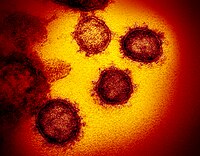
Photo from wikipedia
To the Editor — During the coronavirus disease 2019 (COVID-19) surge in January 2022 caused by the severe acute respiratory coronavirus virus 2 (SARS-CoV-2) ο (omicron) variant, more infections among… Click to show full abstract
To the Editor — During the coronavirus disease 2019 (COVID-19) surge in January 2022 caused by the severe acute respiratory coronavirus virus 2 (SARS-CoV-2) ο (omicron) variant, more infections among healthcare workers (HCWs) were docu-mented than at any other point in the COVID-19 pandemic. Transmission from infected HCWs to other HCWs and patients is a noteworthy concern. The risk of an HCW acquiring COVID-19 from another HCW is reportedly 3 times higher than contracting it from patients. 1 Given that not all infections are detected, it is critically important that during surges, all infection controls (administrative, engineering, and personal protective equipment [PPE]) are optimized to protect patients and HCW col-leagues. 2 We report a case in which a highly infectious HCW work-ing with profoundly immunosuppressed patients did not transmit SARS-CoV-2 to patients despite multiple close interactions. Our data analysis was approved under the Stanford University Institutional Review Board (IRB) through expedited review. The index HCW was vaccinated with BNT162b2 in December 2020 and January 2021 and received a booster vaccination in October 2021. The HCW was in their usual state of health and had a negative routine screening rtPCR anterior nares swab (self-collected; Color Health, Inc) on the Monday of the week of infection; medical school personnel were required to test weekly regardless of symptoms or exposure history. The following day, the felt mild fatigue in the morning, which soon after and the of
Journal Title: Infection Control and Hospital Epidemiology
Year Published: 2022
Link to full text (if available)
Share on Social Media: Sign Up to like & get
recommendations!